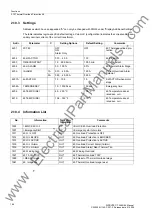
Functions
2.10 Thermal Overload Protection 49
SIPROTEC, 7SJ62/64, Manual
C53000-G1140-C207-2, Release date 01.2008
188
The protection feature therefore represents a thermal replica of the equipment to be protected (overload pro-
tection with memory capability). Both the previous history of an overload and the heat loss to the environment
are taken into account.
When the calculated overtemperature reaches the first settable threshold
49
Θ
ALARM
, an alarm annunciation
is issued, e.g. to allow time for the load reduction measures to take place. When the calculated overtempera-
ture reaches the second threshold, the protected equipment may be disconnected from the system. The
highest overtemperature calculated from the three phase currents is used as the criterion.
The maximum thermally-permissible continuous current
I
max
is described as a multiple of the object nominal
current
I
Nom Obj.
:
I
max
= k ·
I
Nom Obj.
In addition to the k factor (parameter
49 K-FACTOR
), the
TIME CONSTANT
τ
th
and the alarm temperature
49
Θ
ALARM
(in percent of the trip temperature
Θ
TRIP
) must be specified.
Overload protection also features a current warning element (
I ALARM
) in addition to the temperature warning
element. The current warning element may report an overload current prematurely, even if the calculated op-
erating temperature has not yet attained the warning or tripping levels.
Coolant Temperature (Ambient Temperature)
The device can account for external temperatures. Depending on the type of application, this may be a coolant
or ambient temperature. The temperature can be measured via a temperature detection unit (RTD-box). For
this purpose, the required temperature detector is connected to detector input 1 of the first RTD-box (corre-
sponds to RTD 1). If incorrect temperature values are measured or there are disturbances between the RTD-
box and the device, an alarm will be issued and the standard temperature of
Θ
u
= 40 °C is used for calculation
with the ambient temperature detection simply being ignored.
When detecting the coolant temperature, the maximum permissible current
I
max
is influenced by the tempera-
ture difference of the coolant (in comparison with the standard value = 104° F or 40° C). If the ambient or coolant
temperature is low, the protected object can support a higher current than it does when the temperature is high.
Extension of Time Constants
When using the device to protect motors, the varying thermal response at standstill or during rotation may be
correctly evaluated. When running down or at standstill, a motor without external cooling looses heat more
slowly, and a longer thermal time constant must be used for calculation. For a motor that is switched off, the
7SJ62/64 increases the time constant
τ
th
by a programmable factor (k
τ
factor). The motor is considered to be
off when the motor currents drop below a programmable minimum current setting
BkrClosed I MIN
(refer
to "Current Flow Monitoring" in Section 2.1.3). For externally-cooled motors, cables and transformers, the
K
τ
-
FACTOR
=
1
.
Current Limiting
In order to ensure that overload protection, on occurrence of high fault currents (and with small time constants),
does not result in extremely short tripping times thereby perhaps affecting time grading of the short circuit pro-
tection, the thermal replica is frozen (kept constant) as soon as the current exceeds the threshold value
1107
I MOTOR START
.
www
. ElectricalPartManuals
. com






























